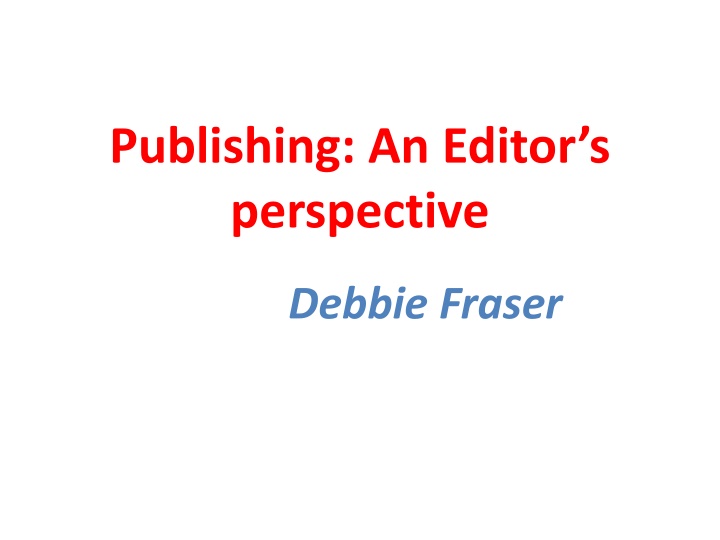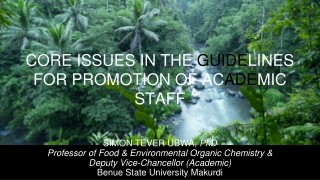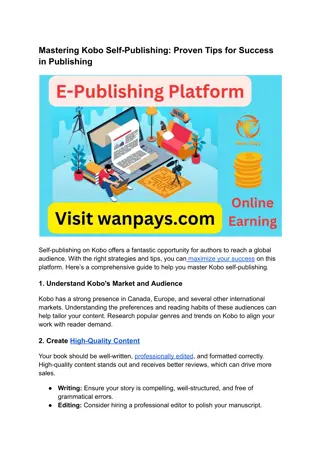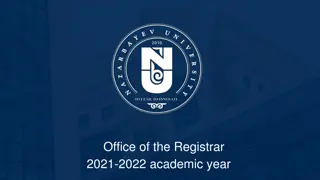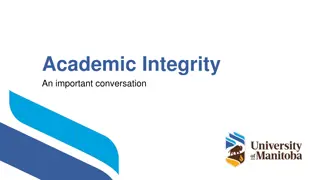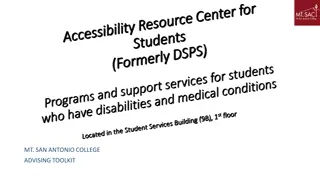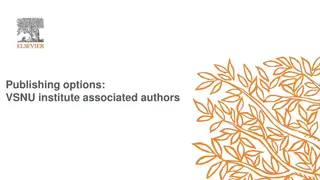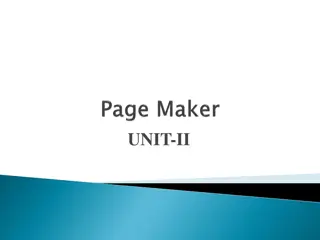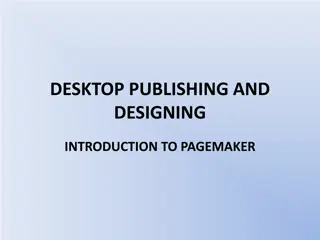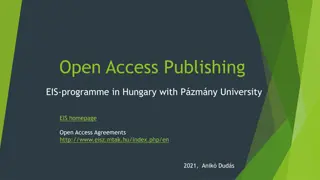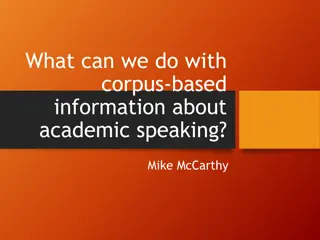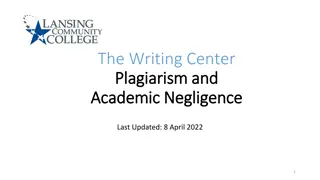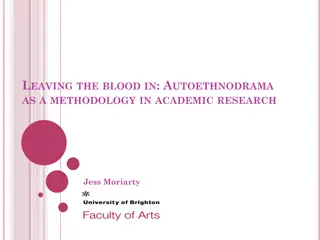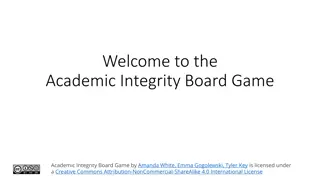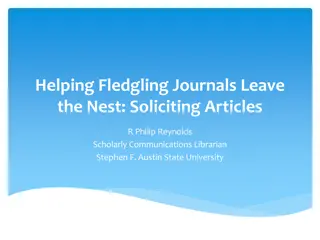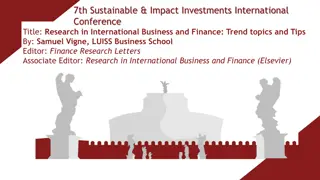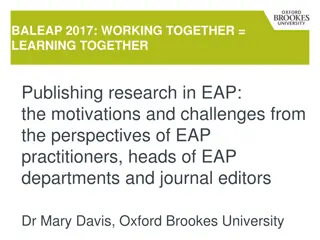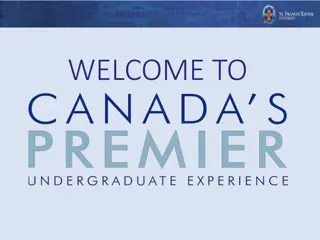Insights into Academic Publishing
Discover the motivations behind publishing, the challenges of fame and fortune, and tips for choosing the right journal. Learn about the benefits of contributing to your field and how to avoid predatory journals. Get started on your publishing journey today!
Download Presentation

Please find below an Image/Link to download the presentation.
The content on the website is provided AS IS for your information and personal use only. It may not be sold, licensed, or shared on other websites without obtaining consent from the author.If you encounter any issues during the download, it is possible that the publisher has removed the file from their server.
You are allowed to download the files provided on this website for personal or commercial use, subject to the condition that they are used lawfully. All files are the property of their respective owners.
The content on the website is provided AS IS for your information and personal use only. It may not be sold, licensed, or shared on other websites without obtaining consent from the author.
E N D
Presentation Transcript
Publishing: An Editors perspective Debbie Fraser
Why publish? Fame and fortune?? Personal satisfaction Academic requirement Building a resume Making a contribution to your field
Fame and Fortune Fortune no- with the exception of commissioned work, most journals do not pay for articles. Consider this- in many science journals you can expect to PAY up to $3000 for the privilege of having them publish your article
Fame Publishing is a great way to get your name out there . Often when groups are looking for a speaker they look to see who is publishing on their topic of interest.
Contributing to your profession Advancing knowledge Clarifying thoughts Informing theory or practice Inviting help or criticism Stirring debate Sharing wisdom or innovation
Choosing a journal How large is the circulation? What is the acceptance rate (high prestige journals have lower rates therefore harder to get accepted) A good fit for your topic? High visibility in your field? Look for journals that publish similar types of work targeted for the same audience you want to reach
Getting Started Write, write, write Offer to review articles, do book reviews or critique colleagues work Read Read Read- be attentive to style, flow, what appeals to you in what you read and what irritates you.
Predatory Journals Have any of you received an email like this? Dear Dr. Debbie Fraser MN RNC, You are cordially invited to submit or recommend articles to the Advances in Lung Cancer (ALC, ISSN: 2169-2726), which is a peer-reviewed open access journal and has been indexed by 13 databases so far. For more information about the journal and its Aims & Scope, please visit the following the website: www.scirp.org/journal/alc. About Our Journal Full peer review: All manuscripts submitted to our journals undergo double blind peer review. Fast publication: Fast peer review process of papers within approximately one month of submission. Low price: Publication Fee Assistance to Authors from Low Income Countries.
Dear Fraser DF, Greetings! I hope you are well. I am writing on behalf of an international publishing house, Science and Education Publishing, USA (http://www.sciepub.com). Science and Education Publishing (SciEP) is a multidisciplinary open access publisher of Journals covering the fields of Science, Technology and Medicine. All SciEP publications are subject to high-quality peer review, editorial and production processes and are freely available online. Starting from October 2012 Science and Education Publishing (SciEP) is launching new series of Journals in different aspects of science, technology and medicine, we have released first issues of some journals on February 2013. American Journal of Public Health Research American Journal of Medical Sciences and Medicine American Journal of Pharmacological Sciences American Journal of Medicine Studies American Journal of Medical and Biological Research American Journal of Clinical Medicine Research American Journal of Nursing Research Journal of Preventive Medicine American Journal of Hypertension Research
Proliferation of Open-Access Publishers True peer-reviewed, open access journals play an important role in the dissemination of publically funded research Major granting agencies require publication of results in an open-access format On the other hand, Scientific & Academic Publishing, USA lists its address in the middle of a six lane highway
Developing an Outline Clarify the following 3 things before you begin to write Your purpose Your audience Scope of your material Other things to think about Content- key points to be covered Features- headings, tables, boxes Deadline- give yourself a timeline to work
OUTLINE I. Introduction A. Grab attention B. State thesis II. Body A. Build points B. Develop ideas C. Support main claim III. Conclusion A. Reemphasize main idea From: http://owl.english.purdue.edu/workshops/pp/writproc.PPT#258, 3,Why do you need a writing process?
Sample outline Title Introduction- what is the problem and why is it important Scope of the problem Literature review- what is known or not What should be done about the problem Implications- connect your research to the field
Getting permission Permission required for any discretely formatted item (table, figure, illustration) Release/permission required if patient is recognizable
Reviewing the literature With the exception of classic works, the majority of your references should be published within the past five years. If little has been published on your topic- tell your reader that so they know you have done your homework.
Strategies for reviewing the literature Organize the literature review around the key concepts in your article. If your article is about educating APNs then leave out material on bedside nurses Do NOT cite all, rather cite what is relevant Be sure to include influential sources Read the sources you cite!
Referencing Need a balance between too many and too few If info is common knowledge- no need to ref Reference if Citing another s work Providing a definition Citing statistics Citing the results of research Info is not general knowledge
References Submit in the style of the journal (APA, Chicago, MLA etc) Include all references cited in your manuscript Don t include articles in your reference list that aren t cited in your paper Use the most recent edition of textbooks
Primary vs Secondary sources Primary sources are always be used What is a primary source- when a study is done by Smith- Smith s paper is the primary source. When you read a sentence that says Smith found that and the reference is Jones then Jones is a secondary source and when you use Jones as your source you are relying on Jones to interpret the study rather than looking at the study yourself
Accuracy of References Check all references for the following Consistency between references cited and listed references- use the find and replace feature in your WP program Correct spelling of names Accuracy of dates Complete citation Adherence to journal s guidelines
Overcoming Writers Block Successful writers schedule time to write It ALWAYS takes longer than you think! Say NO if you don t have time to take on another project Tips for writer s block Have confidence that you have something important to say Organize your ideas before you write Get your message down first, then go back and polish
Academic vs Clinical Writing Academic paper Smith and Jones (2011) found that colic could be prevented by probiotics. In a randomized study of xxx term infants .Long and colleagues (2009)did a retrospective review of xxx cases of colic in infants born at term and found Clinical paper Recent research suggests that the administration of probiotics may reduce the incidence of colic (Smith and Jones, 2011; Long et al 2009; Mitchell 2007).
Pitfalls to avoid Spelling and grammar mistakes Wrong citation and reference format Old references rather than classics Disorganized thought progression Lack of peer review Writing for the wrong audience
Misconduct or Misadventure? Plagiarism may represent an intent to deceive, that is to take someone else s work and claim it as one s own More often it is a case of either poor writing skills or a poor grasp of the content Students in particular have difficulty with paraphrasing
Journals respond: Reviewers are tasked with checking references and advising in cases of plagiarism Increasingly, journals are resorting to plagiarism detection via text-matching software Ongoing debate about the appropriate response to plagiarism Article retraction Inform the author s employer Print a notice of plagiarism
Self-Plagiarism Question: Can I still submit to a journal if my work has been presented at a scientific meeting or published as a abstract elsewhere? Answer: In most cases yes All major publishing houses (Wiley, Springer, Elsevier, Nature, Oxford, PLOS) do not consider the publication of a dissertation abstract or a pre-print of an article to be a publication a preprint is an un-refereed author version of the article
Self-plagiarism Question: Can I publish two, three or more articles from one study? Answer: referred to as salami-slicing, this is a gray area Most publishers acknowledge that, if more than one paper is published from the same study, there will be some overlap in sections such as sample and methodology HOWEVER - prior publications should be identified At issue - if a meta-analysis counts a duplicate pub as a separate study it can alter results
Natures Response All authors must provide details and pre- prints of all papers that are under consideration, in press or recently published elsewhere that could have any relevance to their submitted work.
Ask yourself Does this manuscript contain enough new data, knowledge, or insight to warrant publication? - Editor, American Journal of Speech-Language Pathology
What are the reviewers looking for? Accuracy Significance Clarity and creativity OR Is it true? Is it new? Is it important?
Reasons for rejection Topic not suited for the audience Not a current topic and not worth revisiting Journal has just published on this topic Failure to even come close to the submission guidelines Plagiarism Major problems with references
What to Do Next Revise and resubmit Find an experienced writing partner to help revise the manuscript Submit to a different journal Begin again with a different topic Consider this a learning experience and move on
Writing Resources http://owl.english.purdue.edu http://www.cariboo.bc.ca/disciplines/ http://web.princeton.edu/sites/writing/Writing_ Center/WCWritingRes.htm http://www.writingcenter.emory.edu/writing.ht ml http://www.lsa.umich.edu/swc/resources/writin gresources/ http://www.blackwellpublishing.com/publicatio nethics/ http://www.wame.org/resources http://www.councilscienceeditors.org/
